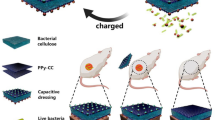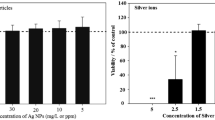Abstract
The growing resistance of many strains of bacteria to antibiotics and antiseptics is becoming a serious problem in medicine. Nano-silver is one of the most prominent products in medicine because it exhibits unusual physicochemical properties and a strong biological activity. In this work an innovative silver deposition technology was applied to temporary polyurethane catheters for haemodialysis. The working conditions of catheters were reproduced through laboratory equipment that ensured the flow of deionized water and simulated body fluid inside the lumina at corporeal temperature. The growth and the adhesion of Staphylococcus aureus on the surface of the device were studied through fluorescence microscopy. ICP-AES was adopted to calculate the amount of silver released from the substrate. The stability of the coating during the whole working life of the device was demonstrated through thermo-gravimetric analysis.







Similar content being viewed by others
References
Singh M, Singh S, Prasad S, Gambhir IS. Nanotechnology in medicine and antibacterial effect of silver nanoparticles. Dig J Nanomater Bios. 2008;3:115–22.
Chen X, Schluesener HJ. Nanosilver: a nanoproduct in medical application. Toxicol Lett. 2008;176:1–12.
Sharma VK, Yngard RA, Lin Y. Silver nanoparticles: green synthesis and their antimicrobial activities. Adv Colloid Interface Sci. 2009;145:83–96.
Lara HH, Ayala-Nunez NV, Ixtepan Turrent LC, Rodrıguez Padilla C. Mode of antiviral action of silver nanoparticles against HIV-1. J Biotechnol. 2010;20:8.
Li WR, Xie XB, Shi QS, Zeng HY, Ou-Yang YS, Chen YB. Antibacterial activity and mechanism of silver nanoparticles on Escherichia coli. Appl Microbiol Biotechnol. 2010;85:1115–22.
Panacek A, Kolar M, Vecerova R, Prucek R, Soukupova J, Krystof V, et al. Antifungal activity of silver nanoparticles against Candida spp. Biomaterials. 2009;30:6333–40.
Lu L, Sun RW, Chen R, Hui CK, Ho CM, Luk JM, et al. Silver nanoparticles inhibit hepatitis B virus replication. Antivir Ther. 2008;13:253–62.
Rai M, Yadav A, Gade A. Silver nanoparticles as a new generation of antimicrobials. Biotechnol Adv. 2009;27:76–83.
Guzmán MG, Dille J, Godet S. Synthesis of silver nanoparticles by chemical reduction method and their antibacterial activity. Int J Chem Biomol Eng. 2009;2:104–11.
Morones JR, Elechiguerra JL, Camacho A, Holt K, Kouri JB, Ramırez JT, et al. The bactericidal effect of silver nanoparticles. Nanotechnology. 2005;16:2346–53.
Radzig MA, Koksharova OA, Khmel IA. Antibacterial effects of silver ions: effect on gram-negative bacteria growth and biofilm formation. Mol Gen Mikrobiol Virusol. 2009;4:27–31.
Feng QL, Wu J, Chen GQ, Cui FZ, Kim TN, Kim JO. A mechanistic study of the antibacterial effect of silver ions on Escherichia coli and Staphylococcus aureus. J Biomed Mater. 2000;52:662–8.
Raffi M, Hussain F, Bhatti TM, Akhter JI, Hameed A, Hasan MM. Antibacterial characterization of silver nanoparticles against E. coli ATCC-15224. J Mater Sci Technol. 2008;24:192–6.
Jung WK, Koo HC, Kim KW, Shin S, Kim SH, Park YH. Antibacterial activity and mechanism of action of the silver ion in Staphylococcus aureus and Escherichia coli. Appl Environ Microbiol. 2008;74:2171–8.
Stewart PS, Costerton JW. Antibiotic resistance of bacteria in biofilms. Lancet. 2001;358:135–8.
Tambe SM, Sampath L, Modak SM. In vitro evaluation of the risk of developing bacterial resistance to antiseptics and antibiotics used in medical devices. J Antimicrob Chemother. 2001;47:589–98.
Wong SSY, Ho PL, Yuen KY. Evolution of antibiotic resistance mechanism and their relevance to dialysis-related infections. Perit Dial Int. 2007;27:272–80.
Pavithra D, Doble M. Biofilm formation, bacterial adhesion and host response on polymeric implants-issues and prevention. Biomed Mater. 2008;3:034003.
Menno LWK, Koole LH. New strategies in the development of antimicrobial coatings: the example of increasing usage of silver and silver nanoparticles. Polymers. 2011;3:340–66.
Dowling DP, Donnelly K, McConnell ML, Eloy R, Arnaud MN. Deposition of anti-bacterial silver coatings on polymeric substrates. Thin Solid Films. 2001;398:602–6.
Korner E, Aguirre MH, Fortunato G, Ritter A, Ruhe J, Hegemann D. Formation and distribution of silver nanoparticles in a functional plasma polymer matrix and related Ag+ release properties. Plasma Process Polym. 2010;7:619–25.
Samuel U, Guggenbichler JP. Prevention of catheter-related infections: the potential of a new nano-silver impregnated catheter. Int J Antimicrob Agents. 2004;23:S75–8.
Pollini M, Sannino A, Maffezzoli A, Licciulli A. Antibacterial surface treatments based on silver clusters deposition. European Patent No. EP1986499, 2008.
Pollini M, Russo M, Licciulli A, Sannino A, Maffezzoli A. Characterization of antibacterial silver coated yarns. Mater Med. 2009;20:2361–6.
Pollini M, Paladini F, Licciulli A, Maffezzoli A, Sannino A. Engineering nanostructured silver coatings for antimicrobial applications. Nanoantimicrob Prog Prospect. 2012. doi:10.1007/978-3-642-24428-5_11.
Pollini M, Paladini F, Catalano M, Taurino A, Licciulli A, Maffezzoli A, et al. Antibacterial coatings on haemodialysis catheters by photochemical deposition of silver nanoparticles. Mater Med. 2011;22:2005–12.
Kokubo T, Kushitani H, Sakka S, Kitsugi T, Yamamum T. Solutions able to reproduce in vivo surface-structure changes in bioactive glass-ceramic A-W3. J Biomed Mater Res. 1990;24:721–34.
Hazeu W, Hueck HJ. The use of β-propiolactone for the sterilization of heat-labile materials. Van Leeuwenhoek A. 1965;31:295–300.
Sambrook J, Russell DW. Molecular cloning. A laboratory manual. 2nd ed. New York: Cold Spring Harbor Laboratory Press; 2001.
Woodyard LL, Bowersock TL, Turek JJ, McCabe GP, DeFord J. A comparison of the effects of several silver-treated intravenous catheters on the survival of staphylococci in suspension and their adhesion to the catheter surface. J Controlled Release. 1996;40:23–30.
Crabtree JH, Burchette RJ, Siddiqi RA, Huen IT, Hadnott LL, Fishman A. The efficacy of silver-ion implanted catheters in reducing peritoneal dialysis-related infections. Perit Dial Int. 2003;23:368–74.
Gray JE, Norton PR, Alnouno R, Marolda CL, Valvano MA, Griffiths K. Biological efficacy of electroless-deposited silver on plasma activated polyurethane. Biomaterials. 2003;24:2759–65.
Kumar R, Munstedt H. Silver ion release from antimicrobial polyamide/silver composites. Biomaterials. 2005;26:2081–8.
Stobie N, Duffy B, McCormack D, Colreavy J, Hidalgo SJ. Prevention of Staphylococcus epidermidis biofilm formation using a low-temperature processed silver-doped phenyltriethoxysilane sol-gel coating. Biomaterials. 2008;29:963–9.
Schierholz JM, Lucasj LJ, Rump A, Pulverer G. Efficacy of silver-coated medical devices. J of Hosp Infect. 1998;40:257–62.
Schierholz JM, Beuth J, Pulverer G. Silver-Containing Polymers. Antimicrob Agents Chemother. 1999;43:2819–21.
Damm C, Munstedt H, Rosch A. The antimicrobial efficacy of polyamide 6/silver-nano- and microcomposites. Mater Chem Phys. 2008;108:61–6.
Balaban N, Gov Y, Bitler A, Boelaert JR. Prevention of Staphylococcus aureus biofilm on dialysis catheters and adherence to human cells. Kidney Int. 2003;63:340–5.
Bayston R, Vera L, Mills A, Ashraf W, Stevenson O, Howdle SM. In vitro antimicrobial activity of silver-processed catheters for neurosurgery. J Antimicrob Chemother. 2010;65:258–65.
Acknowledgments
The authors would like to thank Dr. Luca Salvatore from Engineering Department of University of Salento for the kindness in providing his technical support for the experiments.
Author information
Authors and Affiliations
Corresponding author
Rights and permissions
About this article
Cite this article
Paladini, F., Pollini, M., Talà, A. et al. Efficacy of silver treated catheters for haemodialysis in preventing bacterial adhesion. J Mater Sci: Mater Med 23, 1983–1990 (2012). https://doi.org/10.1007/s10856-012-4674-7
Received:
Accepted:
Published:
Issue Date:
DOI: https://doi.org/10.1007/s10856-012-4674-7




